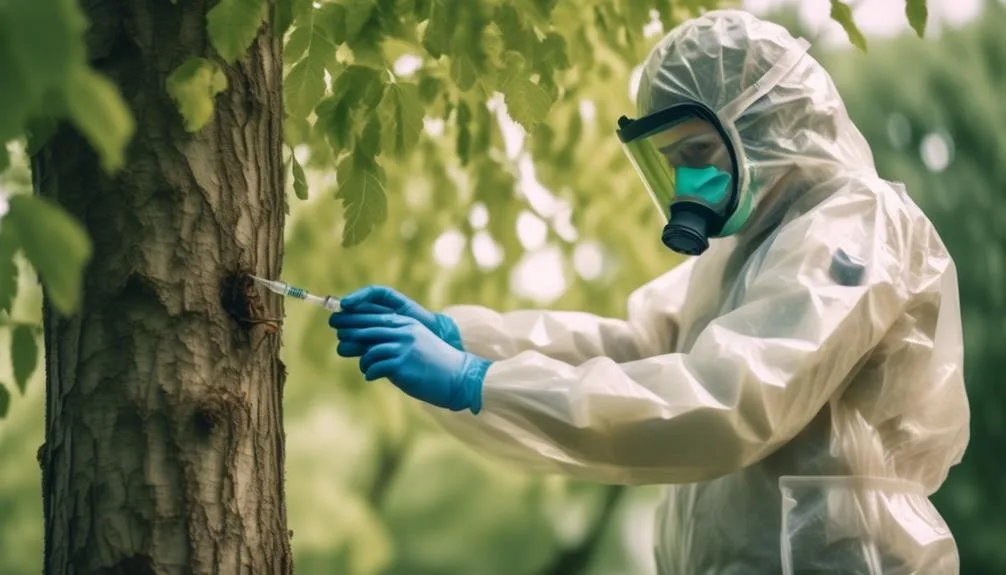Dutch Elm Disease has devastated over 60 million elm trees in the US. Protecting your elms is vital. Taking proactive measures and monitoring can reduce the risk.
Early symptom identification, preventative care, and targeted treatments can safeguard your trees. Let's explore steps to ensure the health and longevity of these majestic trees.
Identifying Dutch Elm Disease Symptoms
Identify Dutch Elm Disease symptoms early to protect your elm trees from this destructive disease. Early detection is crucial for disease resistance and tree preservation. Watch for wilting leaves, yellowing foliage, and browning or curling of the edges.
Another symptom to look out for is the development of 'flagging,' where one or more branches suddenly wilt and die. As the disease progresses, bark beetles may infest the tree, leaving behind small, D-shaped exit holes.
If you notice these signs, act quickly to prevent the spread of the disease. Pruning infected branches and burning them can help stop the disease from spreading. Remember, early identification is key to preserving the health of your elm trees.
Implementing Preventative Tree Care Measures
To protect your elm trees from Dutch Elm Disease, it's essential to implement preventative tree care measures that can help strengthen their resistance to the disease.
Soil management plays a crucial role in preventing Dutch Elm Disease. Ensure proper drainage to avoid waterlogged soil, as the disease thrives in moist conditions. Regularly aerating the soil and adding organic matter can improve its structure and nutrient content, promoting tree health.
Additionally, controlling insect populations around your elm trees is vital. Insect control measures, such as applying insecticidal treatments or using sticky traps, can help minimize the spread of the disease by reducing the number of elm bark beetles, the primary carriers of Dutch Elm Disease.
Applying Fungicidal Treatments
Strengthening your elm trees' resistance to Dutch Elm Disease through soil management and insect control forms a solid foundation for their protection. Another crucial aspect of safeguarding them involves applying fungicidal treatments. When it comes to applying fungicidal treatments, consider the following:
- Fungicidal application techniques: Properly applying fungicides is essential for their efficacy. Ensure thorough coverage of all tree parts, including leaves, stems, and branches, following the specific instructions for the chosen fungicidal product.
- Long term effectiveness: Choose fungicides known for their long-lasting effects to provide extended protection against Dutch Elm Disease. Look for products that offer residual activity, reducing the frequency of applications needed.
- Professional consultation: Seeking advice from certified arborists or tree care professionals can help in determining the most suitable fungicidal treatments for your elm trees and their long-term effectiveness.
Pruning and Sanitation Practices
Prune and maintain sanitation practices to protect your elm trees from Dutch Elm Disease and ensure their long-term health and vitality.
When pruning, focus on removing dead or diseased branches, as these can attract the elm bark beetles that spread the disease. It's also essential to promptly dispose of any infected wood to prevent further spread.
Consider planting disease-resistant elm species, such as the American Elm or the Princeton Elm, to reduce susceptibility.
Additionally, prioritize soil health around your elm trees by ensuring proper drainage and avoiding soil compaction. Healthy soil promotes strong root systems, which are crucial for the overall health and resilience of your elm trees.
Monitoring and Early Detection
Maintain a vigilant eye on your elm trees for any signs of wilting or yellowing leaves, as early detection of Dutch Elm Disease is crucial for effective management and protection. Here are some key steps to monitor and detect Dutch Elm Disease early:
- Regular Inspections: Schedule regular inspections to check for any signs of wilting, yellowing, or browning of leaves on your elm trees.
- Elm Tree Resistance: Consider planting disease-resistant elm tree varieties, as they're less susceptible to Dutch Elm Disease.
- Disease Resistant Cultivars: Look into disease-resistant cultivars such as 'Valley Forge' or 'Princeton' that have shown higher resistance to Dutch Elm Disease.
Conclusion
Incorporating regular preventive measures is crucial for safeguarding elm trees from Dutch elm disease. This includes implementing fungicidal treatments, which can effectively control the spread of the disease. Proper pruning is also essential to remove infected branches and prevent the disease from spreading further. Additionally, vigilant monitoring is necessary to detect any signs of infection early on and take immediate action. By dedicating attention to these practices, you can ensure the long-term health and vitality of your trees.

My interest in trees started when I first saw the giant sequoias in Yosemite.
I was a teenager then, and I remember thinking, “I need to learn more about this.”
That moment stuck with me.
A few years later, I went on to study forestry at Michigan Tech.
Since graduating, I’ve worked in a mix of hands-on tree care and community education.
I’ve spent over ten years helping people understand how to plant, maintain, and protect the trees in their neighborhoods.
I don’t see trees as just part of the landscape.
They are living things that make a real difference in our daily lives.
